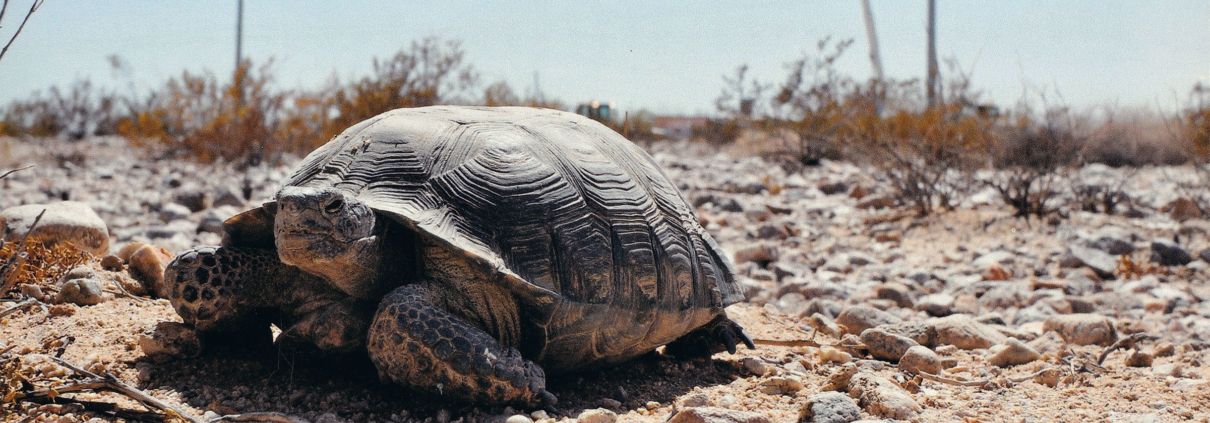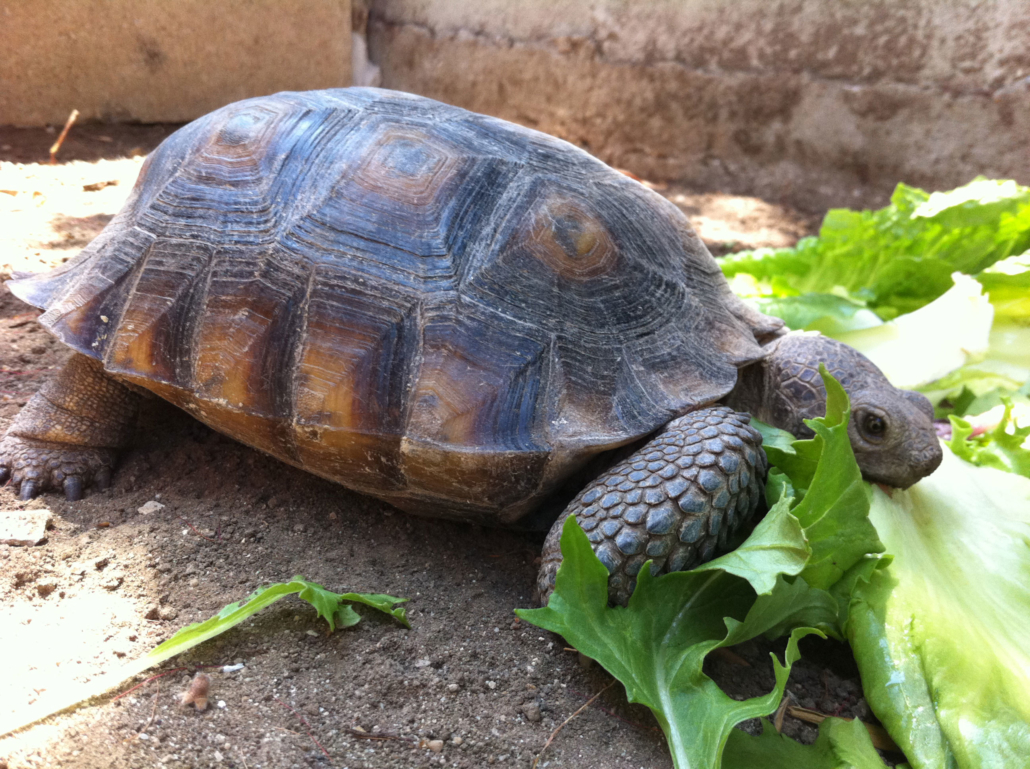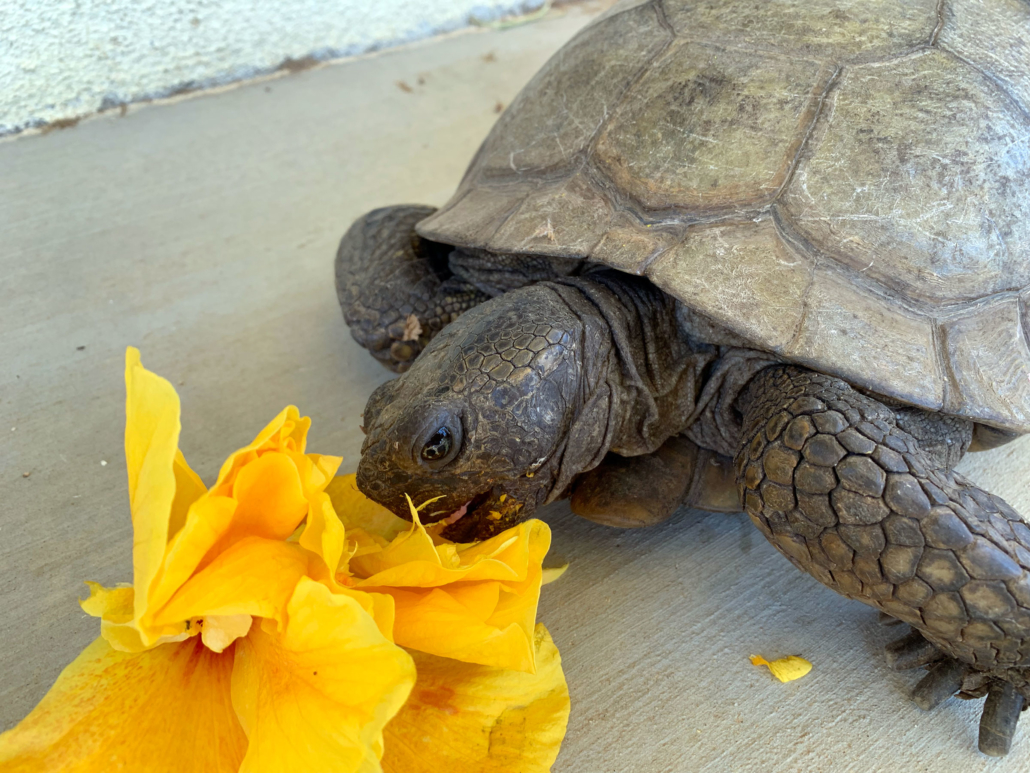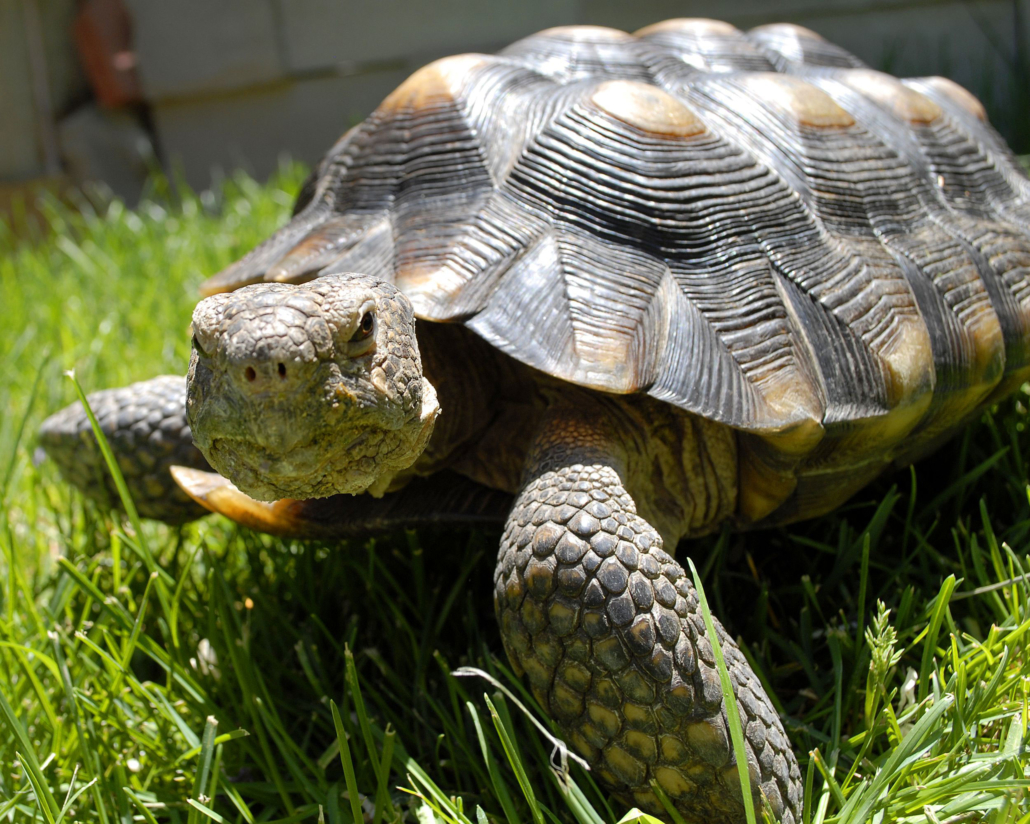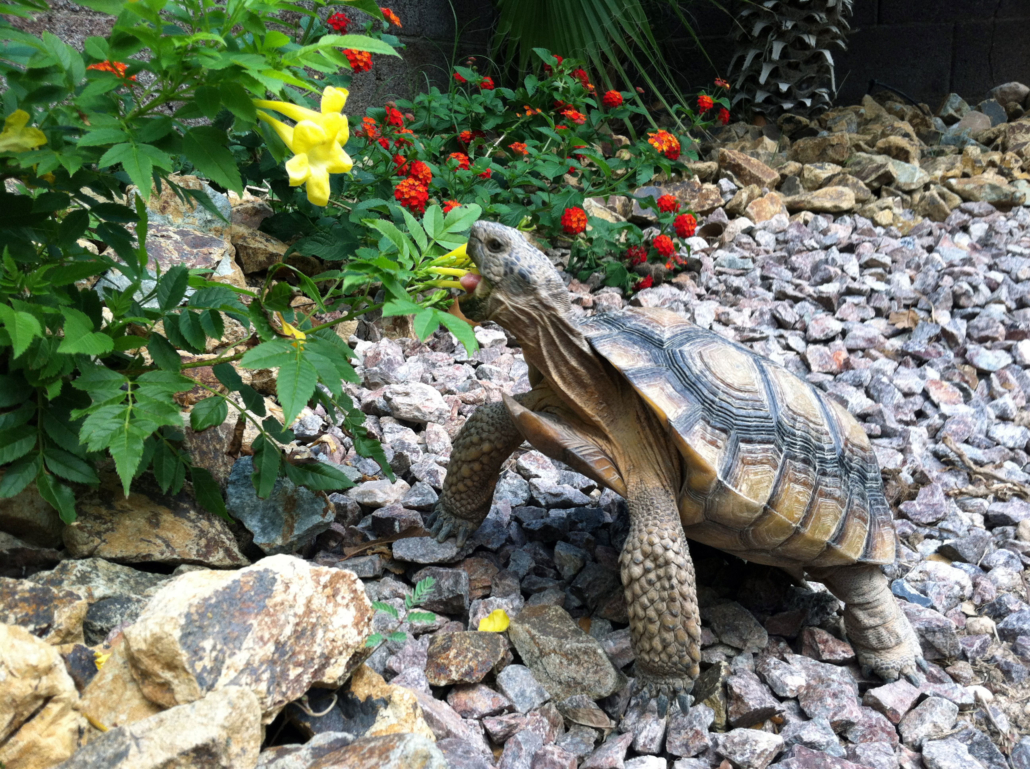Guidelines for Desert Tortoises in Captivity
Desert tortoises have been kept in captivity for many years. While captive maintenance of pet desert tortoises is legal, there are laws and guidelines for keeping them in captivity. In most areas, it is illegal to collect wild desert tortoises for pets. As well, it is illegal in most areas to release captive desert tortoises into the wild. The Desert Tortoise Council strongly recommends that any person who keeps desert tortoises in captivity or who wishes to keep desert tortoises in captivity adhere to these laws.
Legal Status of Captive Desert Tortoises
Federal Law: Agassiz’s desert tortoises held in possession prior to August 20, 1980 in Utah and prior to August 4, 1989 in Arizona, California, and Nevada (50 Code of Federal Regulations 17.11(h)) are not subject to the federal Endangered Species Act, provided that the purposes of such holding were not contrary to the purposes of the Act; and that the wildlife was not held in the course of a commercial activity (50 Code of Federal Regulations 17.4). Because Arizona, California, Nevada, and Utah have laws that prohibit the movement of Agassiz’s and Morafka’s desert tortoises out of state, such interstate movement is prohibited under the federal Lacey Act (16 U.S.C. 3372(a)(2)(A)). In addition, they may not be sold (50 Code of Federal Regulations 12.37 (a)(4)).
In Arizona, California, and Nevada, legally obtained captive desert tortoises and their progeny may be kept as pets, provided that the custodian complies with the respective State’s Wildlife Board or Commission and Department/Division rules regarding desert tortoises (Berry and Duck. 2000). In Utah, the rules for possessing a captive desert tortoise are more restrictive (see below).
In Arizona, lawfully obtained desert tortoises may be privately adopted. Arizona Game and Fish Commission Order 43, Subsection E, limits possession of a captive desert tortoise to one per person per household, and directs progeny to be gifted to another person within 24 months of hatching or as directed by the Arizona Game and Fish Department (R12-4-407 (A)).
In California, it is illegal to sell, purchase, harm, take, possess, transport, or shoot a projectile at a tortoise (Gopherus) (California Fish and Game Code 5000). It is illegal to have a tortoise as a pet unless it was acquired prior to 1972. (California Fish and Game Code 5001). While there is no legal limit to the number of desert tortoises a California resident may possess in state, the California Department of Fish and Wildlife strongly discourages having males and females together in captivity or breeding captive desert tortoises.
In Nevada, desert tortoises may be legally kept as pets if they were held in captivity prior to listing under the Endangered Species Act (August 4, 1989 (50 Code of Federal Regulations 17.4, Nevada Administrative Code (NAC) 503.093). Progeny of legally held desert tortoises are protected from take under the Endangered Species Act (50 Code of Federal Regulations 17.4). Take is defined as to harass, harm, pursue, hunt, shoot, wound, kill, trap, capture, or collect, or to attempt to engage in any such conduct (section 3(19), federal Endangered Species Act of 1973, as amended). Possession, basic care, or non-commercial transfer of such progeny in captivity are not prohibited (16 U.S. Code 1532, 50 Code of Federal Regulations 17.3). NAC 503.093 requires that any desert tortoise not already held in captivity on or before August 4, 1989, must be acquired through an adoption program approved by the U.S. Fish and Wildlife Service and must be registered with the Tortoise Group. The release of pet or captive desert tortoises to the wild is illegal without prior authorization from the Nevada Department of Wildlife (NAC 503.135, NRS 501.105, NRS 501.181, NRS 503.597).
In Utah, a person must obtain a Certificate of Registration from the Utah Division of Wildlife Resources to legally possess a captive desert tortoise. Only one captive tortoise will be placed in each household and only to residences outside of Washington, Kane, and Iron Counties (Berry and Duck 2000, SWPARC 2019). The release of captive desert tortoises to the wild is illegal.
Why a Captive Tortoise Should Not Be Released into the Wild
There are several reasons why a captive tortoise, including captive desert tortoises, should not be released into the wild.
- Many captive tortoises are infected with one or more pathogens that cause highly infectious diseases that are easily transmitted to other tortoises (but not people). The disease(s) is/are usually fatal to wild tortoises because they live in a physiologically stressful environment (e.g., limited nutritious food, limited water). Stress suppresses the tortoise’s immune system. The result is the pathogen flourishes resulting in the disease killing the tortoise.
- Releasing a captive tortoise into the wild may displace resident wild tortoises and cause additional physiological stress through competition for limited resources such as nutritious food or water. Many wild tortoise populations are already threatened with loss and deterioration of habitat (e.g., low quality food availability, etc.). The amount of undisturbed desert habitat decreases yearly because of human activities (e.g., construction, development, roads and trails, and other human pressures). The quality of remaining habitat is also decreasing because of the many demands by humans for land use. Desert habitat recovers very slowly from disturbance. As a result, tortoise habitats can support progressively fewer individuals.
- Research indicates that several genetically distinct tortoise populations exist within the range of Agassiz’s desert tortoise and Morafka’s desert tortoise. A tortoise from one genetically distinct population should not be released into a tortoise population that is genetically different. Often the custodian does not know the location in the desert from which the captive tortoise was removed.
- Released captive tortoises can harm wild tortoises by interfering with the social structure. Wild tortoises have well-defined activity areas and often defend territories and burrows. The introduction of new tortoises to an area can stimulate fights for burrows, food, and other resources.
- A captive tortoise is likely maladapted to conditions in the wild; they would not likely survive very long. Unlike wild tortoises, captive tortoises with symptoms of the disease can be kept alive and healthy through good husbandry practices for many years. Such captive tortoises should be provided with adequate high-quality food and water, thus substantially reducing their stressful environment.
Consequently, the release of any species of captive tortoise into the wild is a violation of the Federal Endangered Species Act, Arizona Revised Statute 17-306, the California Endangered Species Act, Nevada Administrative Code (NAC 503.135, Nevada RS 501.105, NRS 501.181, NRS 503.597, and Utah Division of Wildlife Resources (Rule R657-53-6).
What to Do If You Found a Tortoise in an Urban Setting, If You Want a Desert Tortoise for a Pet, or If You Want to Find a New Home for a Captive Tortoise
Some custodians of captive tortoises may not be able to keep their pets; tortoises can live as long as humans can. Some people may want to become custodians. In other instances, a captive desert tortoise may escape from their yard in an urban situation, and the finder of the tortoise may want to keep it as a pet or find a new home for it. To learn how you can find a new home for a captive tortoise and help native desert tortoises from being exposed to potentially fatal diseases, please refer to the procedures described below for the state in which you reside.
In Arizona
The Arizona Game and Fish Department (AGFD) is the primary “adoption agency” for captive desert tortoises that cannot be released into the wild, because “captive tortoises can transmit diseases that can decimate Arizona’s wild populations.” The AGFD has a website that provides information on how to adopt and care for desert tortoises that occur in Arizona. Please visit the Captive Care section of azgfd.com to obtain information on adoption (Desert Tortoise Adoption Guide) and an application for adoption (Desert Tortoise Adoption Application). There is no adoption fee, but a donation amount is suggested.
There is a Desert Tortoise Adoption Hotline (844 896-5730) and email (email hidden; JavaScript is required) in Arizona. The Arizona-Sonora Desert Museum (520 883-3062, desertmuseum.org/programs/tap.html) in the Tucson Area is a state-sanctioned Adoption Facility.
In California
The California Department of Fish and Wildlife has an agreement with the California Turtle and Tortoise Club (CTTC) regarding the placement and care of captive tortoises. The CTTC has local chapters that will work with you about placing tortoises in new homes (“adoption”), registering the tortoise, or retrieving unwanted captive tortoises (“re-homing”). These services are free; however, you are welcome to donate to the CTTC, as it is a nonprofit organization. For more information about how to adopt a captive desert tortoise or “re-home” a captive tortoise you are no longer able to care for, please visit the CTTC website at tortoise.org/cttc/adoption.html.
In Nevada
In Nevada, please contact the Tortoise Group for adoption and care of tortoises at 702-739-7113 or https://tortoisegroup.org/. This website has information on what to do if you want a tortoise, if you found a tortoise, or if you want to “re-home” a tortoise. Information on adoption and registering your tortoise may be found at tortoisegroup.org/adoption. The Tortoise Group is a nonprofit organization. Their services are free, but you are welcome to donate to the Tortoise Group for the services they provide.
In Utah
The Utah Division of Wildlife Resources has an adoption program for captive Mojave desert tortoises. For more information, please call 801-538-4701 or download/view the pdf.
Additional Information
Arizona, California, Nevada, and Utah do not allow for the transport or export of desert tortoises outside their respective states. At this time, the California Turtle and Tortoise Club and the Tortoise Group are unable to assist with out-of-state requests. Please contact your local animal rescue society, reptile and turtle/tortoise rescue organization, animal shelter, etc. and inquire if they can help with your request.
Tortoise Care and Husbandry Websites
To find information about how to maintain a desert tortoise in captivity, please visit the following websites:
Arizona Exotic Animal Hospital
Arizona Game and Fish Department
California Turtle and Tortoise Club
Literature Cited and Additional Resources
Arizona Game and Fish Commission. 2019. Commission Order 43: Reptiles. (accessed 2019-9-27).
Arizona Game and Fish Commission. 2019. Arizona Revised Statute 17-306. Importation, transportation, release or possession of live wildlife; violations; classification. (accessed 2019-10-3).
Arizona Game and Fish Commission. 2019. Arizona Administrative Code R 12-4-402. Chapter 4 Game and Fish Commission. Section 402. Live Wildlife: Unlawful Acts. (accessed 2019-10-3).
Arizona Game and Fish Department. 2019. Tortoise Adoption Program – Adopting and caring for desert tortoises. (accessed 20119-9-11)
Arizona-Sonora Desert Museum. 2019. Care, Husbandry and Diet of the Desert Tortoise Gopherus (Xerobates) agassizii. (accessed 2019-9-11)
Berry, K.H. 1993. Answering questions about desert tortoises: a guide for people who work with the public in California. Bureau of Land Management, California Desert District Office. BLM-CA-PT-93-003-6840. Obtained from BLM Library, SC-653, BLDG. 50, DENVER FEDERAL CENTER, P. 0. BOX 25047, DENVER, CO 80225-0047.
Berry, K.H. and T.A. Duck. 2000. Answering questions about desert tortoises: a guide for people who work with the public.
California Department of Fish and Wildlife. 2019. Desert tortoise adoption. (accessed 2019-9-11).
California Fish and Game Commission. 2019. Fish And Game Code – Division 5. Protected Reptiles And Amphibians [5000 – 5062] Chapter 1. Turtles [5000 – 5002] (Chapter 1 Enacted By Stats. 1957, Ch. 456.). (accessed 2019-9-27).
California Turtle and Tortoise Club. 2019. Turtle and Tortoise Adoption. (accessed 2019-9-11).
Nevada Department of Wildlife. 2019. Desert Tortoise. (accessed 2019-9-9).
Nevada Department of Wildlife. 2019. Living with Wildlife. Reptiles & Snakes, Desert Tortoise (Gopherus agassizii). (accessed 2019-9-9).
Southwest Partners in Amphibian and Reptile Conservation. 2019. Desert tortoise. (accessed 2019-10-5).
The Tortoise Group. 2019. Home page. (accessed 2019-9-9).
U.S. Fish and Wildlife Service. 2019. Endangered Species Act of 1973, as amended. (accessed 2019-9-27).
U.S. Fish and Wildlife Service. 2019. Pre-act wildlife. 50 Code of Federal Regulations 17.4 (accessed 2019-10-5).
U.S. Fish and Wildlife Service. 2019. Lacey Act of 1900 and amendments. (accessed 2019-10-11).
Utah Division of Wildlife Resources. 2019. Certificates of Registration (CORs) – Information and application forms for common CORs. (accessed 2019-9-9).
Utah Division of Wildlife Resources. 2019. Possession of a Desert Tortoise (R657-3) Application for Certificate of Registration. (accessed 2019-9-9).
Utah Division of Wildlife Resources. 2019. Administrative Rule R657-53.Amphibian and Reptile Collection, Importation, and Possession. (accessed 2019-9-9)

